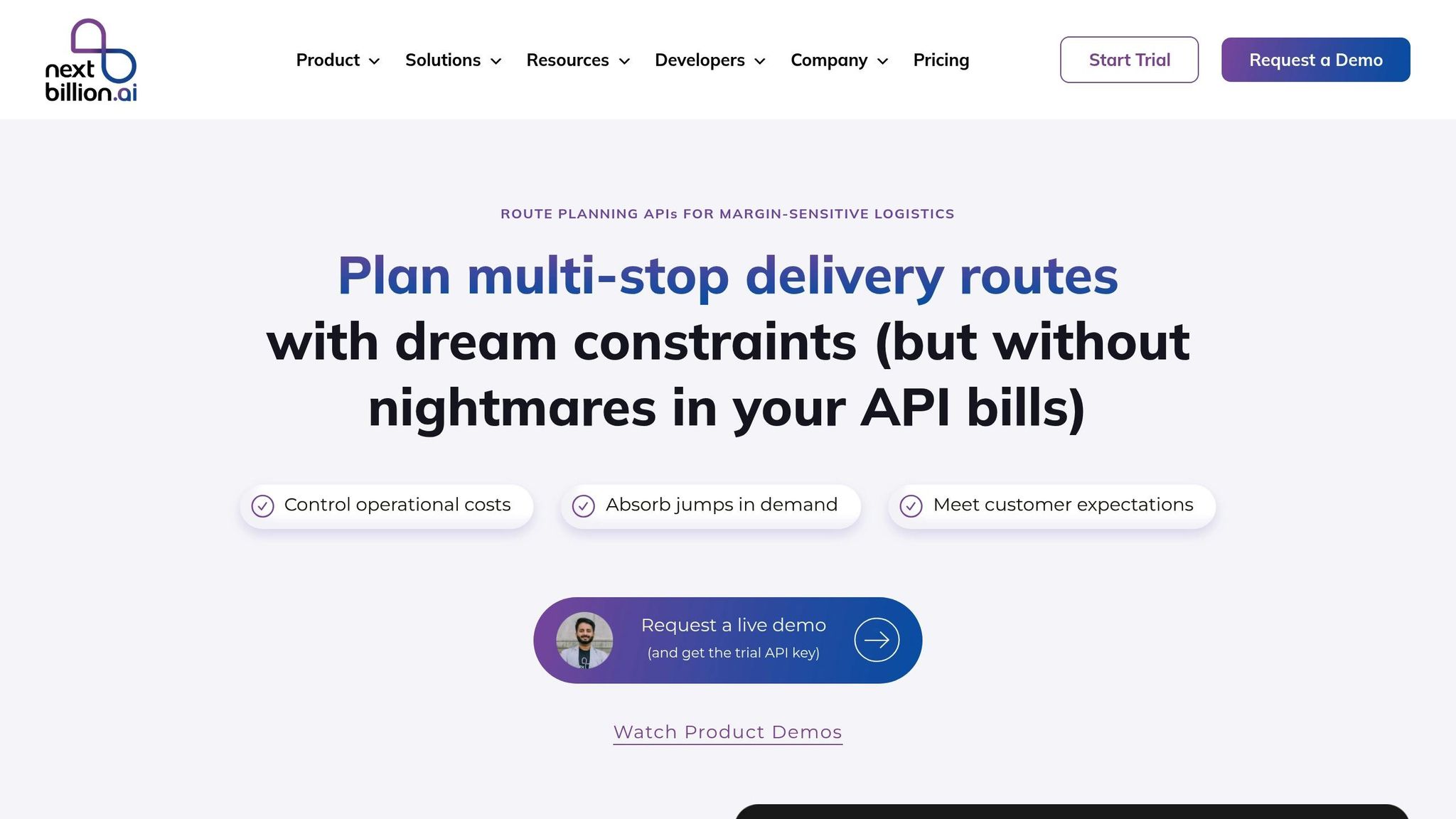AI-powered route planning is transforming field services by improving efficiency and reducing costs. Here's what you need to know:
- Save Time and Money: AI calculates the shortest, most efficient routes, reducing travel time, fuel costs, and vehicle wear.
- Real-Time Adjustments: Routes adapt instantly to traffic, weather, delays, or last-minute changes.
- Better Client Service: Accurate arrival times, proactive updates, and faster responses improve customer satisfaction.
- Mobile Tools for Teams: Technicians get live navigation, schedule changes, and job updates on their devices.
How It Works: AI processes live traffic, weather, GPS, and service data to create and adjust routes. It considers distance, time, urgency, and team skills to ensure the best outcomes.
Key Benefits:
- 15–25% reduction in travel time
- 20–30% savings on fuel
- 10–15% more daily appointments
Ready to improve your field service operations? Start by analyzing your current process, choosing AI routing software like Routemize, and tracking key performance metrics.
Main Advantages of AI Route Planning
Cutting Costs and Saving Time
AI-powered route planning helps lower costs by reducing travel distances, which means less fuel consumption and less wear and tear on vehicles. It calculates the best routes by analyzing factors like:
- Distance: Choosing the shortest path
- Fuel: Reducing unnecessary stops to save gas
- Vehicle: Avoiding tough road conditions
- Time: Balancing service times and travel schedules
Routemize uses historical traffic patterns combined with live updates to cut travel time, allowing technicians to spend more time with clients. Real-time route adjustments make these savings even better.
Real-Time Route Adjustments
Live updates make operations smoother by responding to changes instantly. The system adapts to:
- Traffic: Avoids accidents or construction zones
- Weather: Adjusts routes based on conditions
- Schedule: Handles last-minute cancellations or added stops
- Delays: Updates timing if services take longer than expected
By processing these changes on the fly, Routemize ensures field teams stay on the best routes all day.
Improving the Client Experience
Optimized routes make service more predictable and reliable. Teams can provide:
- Accurate arrival windows: Clients know when to expect service
- Proactive updates: Automated notifications keep clients informed
- Reliable scheduling: Consistent and dependable service
- Fast responses: Better handling of urgent requests
This level of precision not only improves efficiency but also helps maintain high service quality.
AI Route Planning Process
Data Sources and Processing
AI-powered route planning pulls information from various sources to create efficient routes:
- GPS coordinates: Provides exact locations for each stop.
- Service details: Includes appointment durations, required skills, and priority levels.
- Traffic patterns: Combines historical data with real-time traffic updates.
- Road network data: Accounts for speed limits, construction, and road restrictions.
- Weather updates: Considers current and forecasted conditions affecting travel.
This continuous data flow ensures routes stay accurate and up-to-date. The AI engine uses this information to calculate the best paths.
AI Calculation Methods
The AI engine processes this wide range of data to create the most efficient routes by factoring in:
- Distance: Finds the shortest paths between stops.
- Time constraints: Aligns appointments with available time slots.
- Urgency: Prioritizes high-importance service calls without losing efficiency.
- Resource matching: Assigns technicians based on their skills and the job's requirements.
- Traffic forecasting: Predicts delays using historical trends.
Routemize's AI relies on machine learning models that adapt and improve over time. These calculations feed directly into mobile tools used by field teams for real-time operations.
Mobile Tools for Field Teams
The AI-generated routes are integrated into mobile apps that assist technicians with:
- Navigation: Real-time, turn-by-turn directions with voice guidance.
- Job updates: Tools for reporting job completion or delays.
- Schedule adjustments: Instant alerts for route or appointment changes.
- Client details: Quick access to service history and appointment specifics.
- Messaging: Direct communication with dispatch and clients.
These mobile tools ensure field teams can follow their routes efficiently while staying connected to the office. They also respond to real-time changes, helping teams stay productive even when plans shift unexpectedly.
Setting Up AI Route Planning
Assess Current Needs
Start by identifying the challenges in your routing process. Focus on areas like service coverage, peak activity times, travel patterns, client demands, and resource distribution:
- Service area coverage: Outline your service regions and pinpoint high-demand zones.
- Peak hours: Identify periods with the highest service activity.
- Travel patterns: Monitor drive times and total daily mileage.
- Client priorities: Highlight time-sensitive tasks and routine maintenance needs.
- Resource allocation: Evaluate technician availability and specific skill sets.
Set clear benchmarks for travel time, fuel expenses, and the number of completed appointments to measure future improvements.
Choose AI Software
Pick AI routing software that includes features like real-time traffic updates, dynamic route adjustments, mobile app integration, client notifications, and performance tracking.
For example, Routemize offers a system that processes multiple data points to create efficient routes, adjusting to changing conditions throughout the day. This ensures technicians spend more time with clients and less time on the road.
Once implemented, use performance data to measure the software's impact and refine your processes.
Track Results
Keep an eye on key performance indicators (KPIs) to improve efficiency. Below are some metrics to monitor:
| Metric | Description | Target |
|---|---|---|
| Travel Time | Minutes between stops | 15-25% reduction |
| Fuel Usage | Daily fuel consumption | 20-30% savings |
| Appointments | Number of daily completed visits | 10-15% increase |
| Client Wait Time | Difference between scheduled and actual arrival | Under 15-minute variance |
| Response Time | Speed of emergency call handling | 40% faster deployment |
Each week, compare planned routes against actual performance. Use the insights to adjust service areas, scheduling, and resource distribution for better results.
sbb-itb-7020db0
Field Service Route Optimization Demo | NextBillion.ai ...

Solving Common Problems
Once you've optimized your routes, it's important to tackle common operational challenges to keep performance on track.
Data Quality Management
Accurate data is the backbone of effective AI route optimization. Pay close attention to these areas to maintain high data quality:
Address Validation
- Use USPS verification to standardize address formats.
- Include suite/unit numbers and access codes where applicable.
- Add GPS coordinates for precise mapping.
- Note entry points for large buildings or complexes.
Service Time Accuracy
- Regularly compare actual service times with estimates.
- Factor in setup and cleanup times.
- Account for any client-specific requirements.
- Document seasonal changes in service needs.
Set up a weekly review process led by team leads for high-priority clients and frequently visited locations to ensure data stays up to date.
System Connection Issues
Smooth integration between your routing system and other business tools is critical. Here’s how to handle common connection problems:
Mobile Data Coverage
- Use offline mode in areas with poor signal.
- Install mobile signal boosters in service vehicles.
- Enable auto-sync when devices reconnect to the network.
- Keep offline route maps stored on devices as a backup.
Real-time Updates
- Schedule auto-sync intervals (every 15–30 minutes).
- Enable push notifications and SMS backups for critical updates.
- Maintain backup communication protocols to ensure updates reach the team.
Addressing connectivity issues helps you maintain the efficiency provided by AI-driven route planning.
Staff Training Tips
Proper training bridges skill gaps and strengthens system reliability.
| Training Component | Key Focus Areas |
|---|---|
| Initial Setup | Navigation basics, viewing routes |
| Daily Operations | Managing updates, handling changes, notifications |
| Advanced Features | Creating custom routes, handling special cases |
| Troubleshooting | Resolving common issues, using backup procedures |
Ongoing Support
- Assign power users to assist with peer training.
- Hold monthly refresher sessions.
- Provide quick reference guides.
- Set up a help desk for immediate support.
Performance Monitoring
- Track compliance with planned routes.
- Monitor how often manual overrides occur.
- Check the accuracy of completion times.
- Document recurring user challenges.
Use practical, hands-on training sessions that reflect real-world scenarios. Incorporate actual service areas and client locations to make training relatable and effective. Consistent training ensures teams can fully utilize AI-powered routes, improving both efficiency and client satisfaction.
Conclusion
Main Points
AI-powered route optimization is transforming field services by reducing travel time, lowering fuel expenses, and providing reliable scheduling. Routemize achieves this with real-time updates and decisions based on data. Here’s what it brings to the table:
- Consistent scheduling for better service reliability
- Accurate arrival updates to enhance client satisfaction
- Improved efficiency through smarter routing
Let’s break down how you can put these ideas into action.
Getting Started
Follow these steps to boost your field service efficiency:
-
Initial Setup:
- Analyze your current routing process to spot inefficiencies
- Gather historical data on appointment durations
- Define service areas and evaluate team strengths
- Ensure mobile devices have strong data connectivity
-
Implementation:
- Test the system with a small team or in a specific area
- Track travel times and schedule accuracy
- Collect feedback from both field staff and clients
-
Optimization:
- Use performance data to adjust service time estimates
- Refine routing settings based on feedback
- Expand the system to cover your entire operation
Keep your data accurate and invest in regular team training. With these steps, you’ll take full advantage of AI route optimization to streamline your field service operations.


